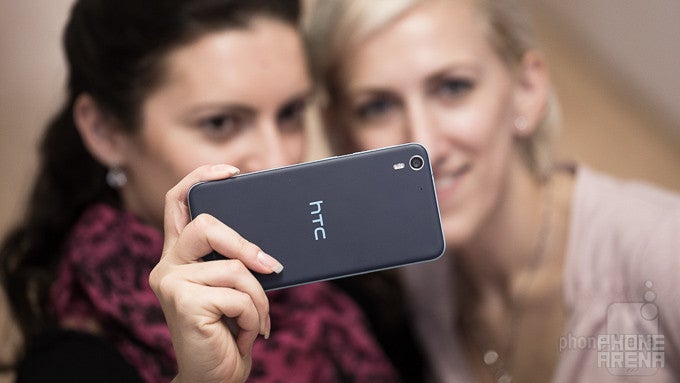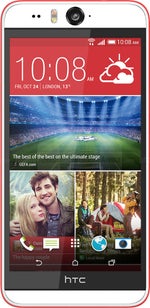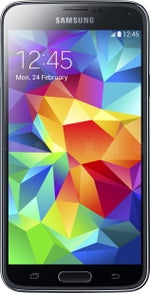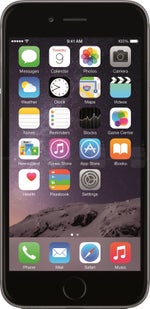HTC Desire EYE Review

Introduction
A month or so ago, HTC decided that it was high time it put an end to the selfie race and unveiled the HTC Desire EYE, a smartphone that is doomed to intrigue with its ginormous 13MP selfie snapper. However, the front-facing camera is just one of the assets of the Desire EYE, because it also packs pretty respectable hardware under its predominantly-plastic hood. On paper, it seems that HTC's foray into selfie-centric phones might be a pretty successful one, but is this truly the case? Let's find out!
In the box:
- handset
- charger
- USB charging cable
Design
A big, surprisingly pleasant to hold handset that has certain issues
Despite its large dimensions (5.97 x 2.91 x 0.33 inches or 151.7 x 73.8 x 8.5 mm) and weight of 5.43 oz (154g), the large HTC Desire EYE does is not unwieldy and feels good in the hand. On the contrary, the device is pleasantly ergonomic and sits good in the hand.This time around, HTC put its faith into hard, matte plastic as a build material, both for the back and for the sides, which is pretty pleasant to touch and provides a more-than-acceptable amount of grip. It does not smudge easily, but still tends to hold a bit of grease, especially if your hands are sweaty or dirty.
It's quite possible that the main culprits for the tall silhouette of the device are the two frontal speakers (neatly hidden in gaps between the display's frames and the top/bottom bezel of the phone) and the large selfie camera up front. These take their toll and make the Desire EYE as tall as a Galaxy Note 4, for example.
Meanwhile, the right edge of the device is home to a set of hardware buttons (power/lock, volume rocker, and a dedicated two-step camera shutter key), the interaction with which is quite unpleasant – they are shallow and it's extremely hard to discern them from the surrounding plastic. The two-step camera button is particularly unpleasant – it does not provide enough feedback about its position. At the left side of the phone, we can find the slots for the nano SIM and the microSD cards, which fit rather tightly inside the frame. The HTC Desire EYE is IPX7-certified, too, which means that it will live to tell the tale if you dip it in the water – in particular, for as long as 30 minutes at a depth of up to a meter.
Display
Excellent outdoor visibility and acceptable color reproduction
Up front, we have a 5.2" 1080p display that has a pretty good pixel density of 424ppi – the display is sharp enough and we failed to discern any individual pixels. It also is very bright, vibrant, and has an excellent outdoor visibility. At the same time, its contrast is top-notch, too, but the color accuracy leaves something to be desired – its readings don't exceed the borders of the sRGB color chart, but the display fails to match with many of the color targets. The Desire EYE reproduces colors a tad bluer than they should be in real life – it has a color temperature of 7248K, noticeably higher than the reference of 6500K. The gamma, at 2.37, is also above the perfect value of 2.2. The viewing angles are mediocre at best, yet acceptable.
Interface and functionality
The best Android 4.4.4 KitKat and Sense 6 have to offer
Naturally, the HTC Desire EYE ships with the maker's own Sense user interface, which runs on top of Android 4.4.4 KitKat, the best of the pre-Lollipop era. Striking a very good balance between on-board features and a no-frills user experience, the selfie-centric device is lightweight and pleasant to work with, as far as interface is concerned.
We have BlinkFeed on board, as well as the Motion Launch feature, which allows you to wake and put the phone to sleep by double tapping the screen – quite useful on a handset like the Desire EYE, not only due to the size, but because of the unimpressive buttons, too. You can either use HTC's own messaging and mail apps or resort to Google's alternatives - Hangouts and Gmail ones. The UI of the Desire EYE can be customized with several different color themes.
Processor and memory
The hardware inside the Desire EYE ensures a no-frills experience
The HTC Desire EYE ships with a Qualcomm Snapdragon 801 MSM8974AB chipset, with four Krait 400 cores running at 2.3GHz. The latter work in concert with an Adreno 330 GPU and 2GB of LPDDR3 RAM. This hardware combination plays out pretty good for the Desire EYE, which shows almost no signs of lag even when heavier tasks need to be processed at hand. The multitasking capabilities of the phone are adequate, too.
We also have 16GB of native storage, roughly 9 of which are available to the end user out of the box. Don't fret, as a microSD card slot is present, too – it supports microSD cards of up to 128GB in size, which is more than enough to store all the selfies you might take.
Internet and connectivity
Regardless of which one you choose, be it HTC's stock web browser or Google Chrome (both of which are preinstalled), the Desire EYE will always treat you to a pleasant browsing experience. Navigating through web pages is smooth, and we experienced little to no interface lag. Text appears crisp and pleasant to look at. The phone comes with support for a wide array of LTE bands (2, 3, 4, 5, 7, 17, 20, 29). Wi-Fi 802.11 a, b, g, n, n 5GHz, GPS, GPS-A, Glonass, Bluetooth 4.0, NFC, and DLNA are also present.
Camera
Both cameras will satisfy you with the images they produce
At the rear of the Desire EYE, we have a 13MP BSI sensor endowed with a 28mm lens that has an F2.0 aperture and a dual LED flash. Autofocus, HDR, and various manual controls. Have in mind that the snapper shoots in a 16:9 mode by default, so to fully utilize those 13 megapixels, you'll have to select a 4:3 shooting mode from the settings menu. The rear camera produces images with an acceptable amount of detail, with close to no artifacts and mostly accurate colors. Even so, it occasionally tends to produce images that are slightly darker than reality. HDR images are quite adequate, too, even with strong backlight present. However, the snapper disappoints when it comes to images that are taken indoors, under artificial lighting, as these come out quite noisy.
Up front, we have a 13MP camera with a BSI sensor that flaunts a 22mm lens and an F2.2 aperture, accompanied by a dual LED flash. Apart from doing its usual job, the latter also doubles as a "torch" that constantly illuminates your face before you take a selfie, but it lacks an Auto mode. The front-facing camera of the HTC Desire EYE performs quite well – usually, the selfies are very detailed, correctly-exposed, and have a decent color reproduction. Even with strong backlight present - in contre-jour - the self-portraits turn out surprisingly good. Software-wise, the selfie camera comes with HDR, Anti-shake, Backlight, Manual controls, and other useful modes. Taking selfies can easily become a game!
All in all, neither the rear nor the front-facing camera are likely to disappoint you, though they aren't particularly great in what they do.
As far as video recording is concerned, both cameras of the HTC Desire EYE are capable of shooting 1080p videos at 30fps and 720p slow-motion ones, but 4K video-recording is a no-no. Both perform in a similar manner – the videos are correctly-exposed (most of the times), with no noticeable artifacts, yet they suffer from the notorious "rolling shutter" effect, as neither has an image stabilization; what's more, the videos are not as detailed as we'd like them to be. Generally-speaking, both cameras perform just “okay” as far as video recording is concerned – nothing impressive, but the Desire EYE will get the job done.
Multimedia
The Desire EYE comes with HTC's own suite of multimedia apps, such as Gallery and Music. Both come with HTC's signature sleek design, though they are not quite feature-laden. Yet, both HTC's Gallery and Music get the job done. The HTC Zoe multimedia tool is also on board.
The audio-reproducing capabilities of the HTC Desire EYE are top-notch – the BoomSound speakers at the front produce pretty deep and loud sounds, with no perceptible audio distortion even at maximum volume. The low frequencies are a bit “shallow” and “flat”, though, but listening to music from the BoomSound speakers will generally result in a pleasant experience.
Call quality
In the telephony department, the HTC Desire EYE fails to impress and performs in a mediocre fashion. Its microphone tends to randomly insert artifacts and slightly distort your voice. At the same time, the top-positioned BoomSound speaker acts as a earpiece, however, its voice reproduction is not very impressive – you'll hear the other side slightly muffled and, generally speaking, not natural at all.
Battery
Nothing to write home about
The Desire EYE has a 2,400mAh Li-Ion battery at the back and HTC says that the handset will last for roughly 22 days in standby mode, while the official talk time is exactly 20 hours. It clocked in at 7 hours and 2 minutes in our custom battery test, which is a good and adequate result. You'll have to wait for 2 hours and 37 minutes in order to see the battery of the Desire EYE charge all the way from 0% to 100%, which is an acceptable result.
Conclusion
There you have it, all the good and the bad about the Desire EYE, HTC's selfie-centric handset. The device will most probably be priced as much as an HTC One (M8), which will pit it against many other devices that sit higher in the food chain. In spite of this, the HTC Desire EYE is arguably the best selfie-centric device out there – it has the upper hand when compared with other selfie-centric phones (the Sony Xperia C3, the Samsung Galaxy Grand Prime, and the Nokia Lumia 730). The phone will have a tough time competing with other upper mid-range and lower high-end handsets. Although it's not as premium as HTC's current flagship, the Desire EYE might be regarded as a viable alternative to the One (M8), especially with those users who highly value their selfie game.
As a whole, we were pleasantly-surprised by the Desire EYE in certain aspects and disappointed in others. HTC could have done better, but this doesn't mean that the Desire EYE is a failure. On the contrary,you should definitely keep an EYE on it.
































Things that are NOT allowed: